Celtic Cross Spread
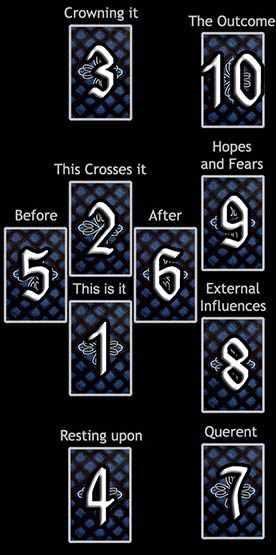
Difficulty: Average
This is probably the most well-known tarot spread. A good, basic spread for beginners to practise with, the Celtic Cross is useful for questions of all types. In this spread, it can be helpful to notice the relationships between the pairings of cards #5 & #9, #1 & #2, #3 & #4, and #6 & #10.
- The significator epitomizes what the reading deals with, the initial situation.
- An added impulse that compounds the significator, which may be either complimentary or contradictory.
- This is what is consciously known (thoughts).
- Unconscious driving forces that may not be known fully (emotions).
- The immediate past regarding the current situation.
- The first future card indicates the immediate future.
- This card represents the reader and their attitude towards cards #1 and #2.
- The external influences, the places and people which influence the topic.
- This tarot card suggests expectations; what is secretly hoped for or feared.
- The second future card reveals the long-term outcome.
Your Celtic Cross Reading
The Crown |
The Outcome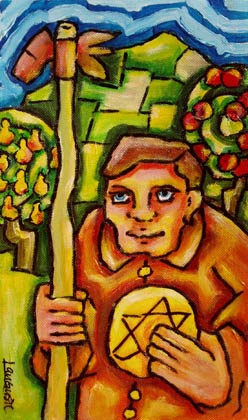 Prince of Coins
External Forces  7 of Wands
|
||
The Recent Past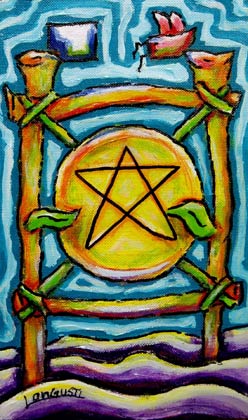 Ace of Coins |
The Crossing Card
|
The Future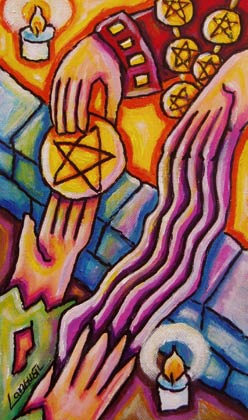 6 of Coins |
|
|
|||
The Significator represents what the main theme of the reading deals with, the initial situation.

The Magician
The symbols of all the elements are shown on the picture as possibilities. The eye, with its triangular shape, refers to the Holy Trinity. It seems as though it has just opened and one can recognise the spokes of the Wheel of Fortune in its iris.
The ribbon of eternity shows us how all possibilities can develop in waves out of the one item. The red background supports the energy of the illustration.
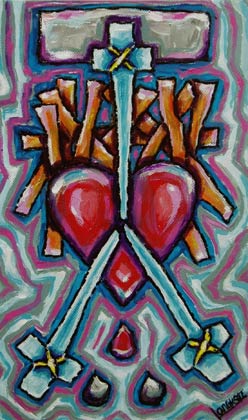
The Crossing Card denotes an added impulse that compounds the initial card, whether complimentary or contradictory.
3 of Swords
The colours red, blue and gray are all mixed together in this scene. Clarity fills the whole picture, but the emotions also play a role. The ten wands in the background are all mixed up.
A cloud obscures or overshadows the scene. The two drops of water show condensation, as the cloud is being influenced by the sword. These drops also represent tears.
The three swords point to a spot on the heart. It is unclear whether they are damaging it, yet one can see a drop of blood.
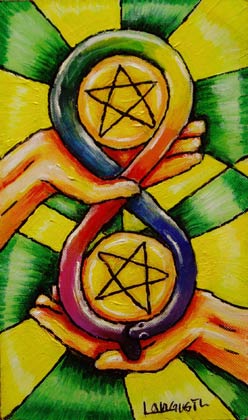
The Crown stands for what the asker is aware of consciously.
2 of Coins
The picture is based on a classical presentation. The alternation is portrayed by the changing of the green and yellow colours and in addition through the movement the snake makes around the two pentacles, fashioned in the circle of colours. This appeals to a repetition of experiences. The double loop relates to our entire path through life.

Foundation card reveals unconscious driving forces that the querent may not be aware of.
The Emperor
The picture has the effect of being rather poor and harsh. The blue colours represent coolness, but due to the red and yellow one can sense a certain energy, which also appears in Aries' head at the corner of the throne, connected astrologically with the Emperor.
The card's number four, which also represents the element earth, can be found in the house in the square of rocks and the crown also shows four spikes and four stones. Further symbols of the Emperor are an orb (symbol of world dominion) and a form of sceptre (symbol of materialism in life).

The Recent Past represents past events and concerns.
Ace of Coins
All the elements are present on the picture, because the element, earth, actually contains all the other elements. The pentacle, as the fourth element, is mounted in a square frame, emphasising its relationship with the number four.

The Future depicts that which lies ahead.
3 of Swords
The colours red, blue and gray are all mixed together in this scene. Clarity fills the whole picture, but the emotions also play a role. The ten wands in the background are all mixed up.
A cloud obscures or overshadows the scene. The two drops of water show condensation, as the cloud is being influenced by the sword. These drops also represent tears.
The three swords point to a spot on the heart. It is unclear whether they are damaging it, yet one can see a drop of blood.

The Querent represents the asker and their attitude towards the subject of the reading.
8 of Cups
Seven cups are covered with a cloth, so that they won't be damaged during absence. A cup is being held in the left hand and a sword in the right. They look like a complementary couple.
There is water to the right and left of the path and one must take care not to tread in it. In the background we can see the Hermit's hut and several hills, which could turn out to be mountains. The waxing moon shows uncertainty. The journey might not be too easy.

External Forces represents the influence of others in your life as well as trends in your relationships with others.
7 of Wands
The beam in the Five of Wands picture has been supported. On this card a hand has taken over the leadership and restrained the different impulses from the other five hands, or as the case may be, straightened them up so that they cannot cause any more damage to the successful work. The top and the bottom of the picture show the two sides of the number seven.

Hopes and Fears shows the expectations you have concerning the outcome of your question.
The Hanged Man
The sole of the foot is turned upwards, the world is turned upside down. This is what the picture shows. The beam and the rope are blue. Rationality, an attempt to consciously act, binds the hanged man. But here there also seems to be hope. Leaves are growing out of wood.
The colour yellow at the bottom of the picture stands for the light which the hanged man experiences when he manages to let himself fall. The wide path in the background leads to a dead-end against blue rocks. Walking back a bit one can find a narrow track which leads around the rocks back into the light. The violet background portrays the night sky. Normal vision is not carried any further.

The Outcome of your question. Interpret this card in the context of the entire reading and as an indicator of the path you are currently on, but not necessarily bound to.
Prince of Coins
The fields and fruit trees are well kept and managed. Everything seems to be in order. The harvest is certain to turn out well. Apart from a few gold buttons, the prince does without any jewellery. His facial expression mirrors his pride in his performance, but at the same time a certain submissiveness.
